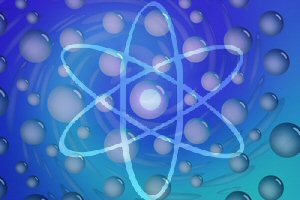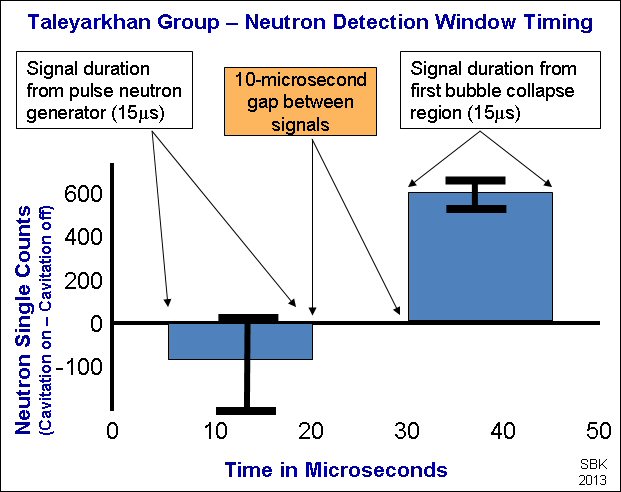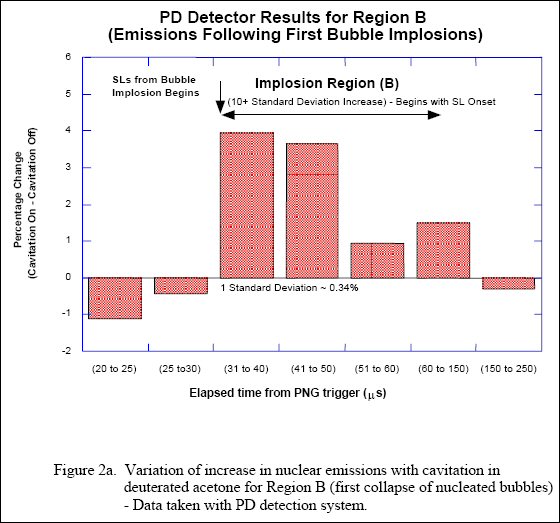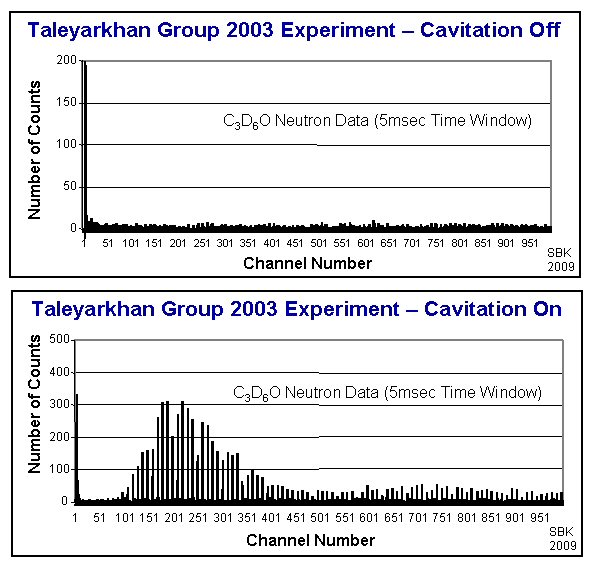
Oak Ridge Nuclear Cavitation Confirmation
July 27, 2013 – By Steven B. Krivit –
This is Part 10 of “2001 Oak Ridge Nuclear Cavitation Confirmation Uncovered.”
This is a New Energy Times Special Report. The first part of this series published on July 18, 2013.
Shapira and Saltmarsh Stand by Their Data (March 2002)
The day the Taleyarkhan group’s paper published, March, 8, 2002, journalist Charles Seife, on the news side of Science, reported Saltmarsh’s speculation about the excess neutrons.
“One possibility [for the excess neutrons] is that the extra neutrons are left over from the 14-MeV neutrons fired into the cylinder,” Seife wrote, “eventually winding up in the detector after skittering about the room. To rule out that scenario, says Saltmarsh, he and Shapira timed the flashes of light from the bubbles and compared them with the arrival times of the extra neutrons. The effect disappeared.”
The question of coincidences was moot, as West explained later in an e-mail to New Energy Times.
“The flaw in Seife’s logic is so obvious,” West wrote. “The number of neutrons would be the same whether there was cavitation or not, whether the acetone was deuterated or not, and whether the acetone was at 20 degrees C or at 0 degrees C. Seife apparently didn’t understand the significance of our control experiments.”
Peter Weiss, writing for Science News on March 9, 2002, cited the Shapira and Saltmarsh document (Ref #31) and the Taleyarkhan group’s rebuttal (Ref #32). Weiss gave the last word to Saltmarsh, who countered the Taleyarkhan group’s rebuttal with a single sentence.
“Not so fast,” Saltmarsh counters. “We stand by our data.”
Shapira and Saltmarsh Submit Comment to Science (March 2002)
In fact, the Taleyarkhan group stands by the Shapira and Saltmarsh data, too. But the Taleyarkhan group did not fight the battle in the media. It did not seem to understand the role of science media in communicating its work to the public. It did not seem to understand the effort it would take to correct facts and public myths once the first impressions took hold. These were hard lessons for the Taleyarkhan group.
After Shapira and Saltmarsh promoted their Web-published document and spoke widely to the media about their unreviewed critique, they submitted a formal scientific comment to Science.
Katie Pennicott, writing in the April 2002 issue of Physics World, reported the forthcoming Shapira and Saltmarsh journal comment. Pennicott reported that Shapira and Saltmarsh had attempted their own replication.
“Shapira and Saltmarsh are now preparing two reports for Science that outline the technical shortcomings of Taleyarkhan’s original work, and give a fuller account of their own attempts to reproduce it,” Pennicott wrote.
On March 28, Shapira and Saltmarsh submitted their comment to Science. Science immediately sent the comments to the Taleyarkhan group, which submitted its reply three weeks later, on April 15. Science accepted the Shapira and Saltmarsh comments three months later, on July 2, and accepted the Taleyarkhan group’s reply on Aug. 19. The two papers published back to back on Sept. 6.
The Shapira and Saltmarsh comment raised questions about neutron/tritium ratios, detector efficiencies and coincidences and concluded, “These inconsistencies cast serious doubt on the claimed evidence for D-D fusion in these experiments.”
In its paper, the Taleyarkhan group responded to the “serious doubts” raised by Shapira and Saltmarsh.
Shapira and Saltmarsh Submit Comment to PRL (July 2002)
On July 17, two weeks after Science accepted Shapira and Saltmarsh’s comment, they submitted a paper to Physical Review Letters. The PRL paper published remarkably fast — 33 days after PRL received it, on Aug. 19, 2002. If Pennicott’s information, “now preparing two reports for Science,” was correct, then this PRL paper may have been the second report Shapira and Saltmarsh originally prepared for Science.
Shapira and Saltmarsh’s PRL paper was on a faster track than their comment to Science. Their PRL paper published before the comment and reply in Science on Sept. 5. Taleyarkhan, the corresponding author of the March 8, 2002, Science paper, was not offered a chance by PRL to submit a paper to go along with the Shapira and Saltmarsh PRL paper.
By July, when Shapira and Saltmarsh submitted their paper to PRL, many news reports had stated that they had attempted their own replication, and the idea had begun to take hold in the public’s mind. The Taleyarkhan group had remained silent.
Shapira and Saltmarsh Make Replication Claim in PRL (August 2002)
They began their PRL paper with the phrase, “We have repeated the experiment of Taleyarkhan et al.” as they had done in the Feb. 20 and March 1 documents, and they directly titled their paper an attempted replication: “Nuclear Fusion in Collapsing Bubbles – Is It There? An Attempt to Repeat an Experiment That Reported D-D Fusion in Bubble Collapse Induced by Cavitation in Deuterated Acetone.”
In the Feb. 20, 2002, and March 1, 2002, documents, even though Shapira and Saltmarsh started out with the phrase “We have repeated the experiment,” they also wrote in the papers that “the cavitation apparatus was operated by the original authors,” that is, the Taleyarkhan group.
That’s not what they wrote in the PRL paper. Shapira and Saltmarsh rephrased the sentence: “The operating condition of the cavitation apparatus was set by the authors of Ref. [6] to be identical to that used in their experiment.”
The content of the PRL paper is mostly the same as the Feb. 20, 2002, and March 1, 2002, documents with one major exception: Shapira and Saltmarsh speculated about background neutrons.
The authors knew that both the ETD and the PD neutron data showed excess neutrons, even statistically significant excess neutrons. They knew that their data had inadvertently confirmed, not disconfirmed, the Taleyarkhan group’s claim. For these reasons, in the PRL paper, Shapira and Saltmarsh knew they could not write that they had seen “no evidence for any excess neutrons,” as they had told the press and the ORNL science writers in March.
Instead, they addressed two possibilities, neither of which they tested. The first was that the intensity of the PNG varied during experiments. This would mean that the intensity of the PNG, by chance, varied directly when cavitation was on or off, when deuterated acetone was used or normal acetone was used, and when the apparatus was chilled to 0 degrees C or not.
Their second explanation is “possibly a change in neutron scattering geometry due to people in the area being at different positions for the two runs.”
Taleyarkhan wrote to New Energy Times and explained what would be required if Shapira and Saltmarsh’s explanation were valid.
“In order for room-return background neutrons to bounce off of us to create such an effect,” Taleyarkhan wrote, “either JaeSeon or I (Shapira mostly remained seated) would have had to be running three feet toward and then three feet away from the test cell every 25 microseconds at speeds of 1,000 m/s to 10,000 m/s constantly for the entire hour. This is ridiculous, besides being impossible. And, of course, their conjecture would have required us to sit still for the entire hour during the run with cavitation off.”
This was the third alternative hypothesis that Shapira proposed.
Next Part: Shapira Confirms He Did Not Perform a Replication
______________________________________________________________
Questions? Comments? Submit a Letter to the Editor.





